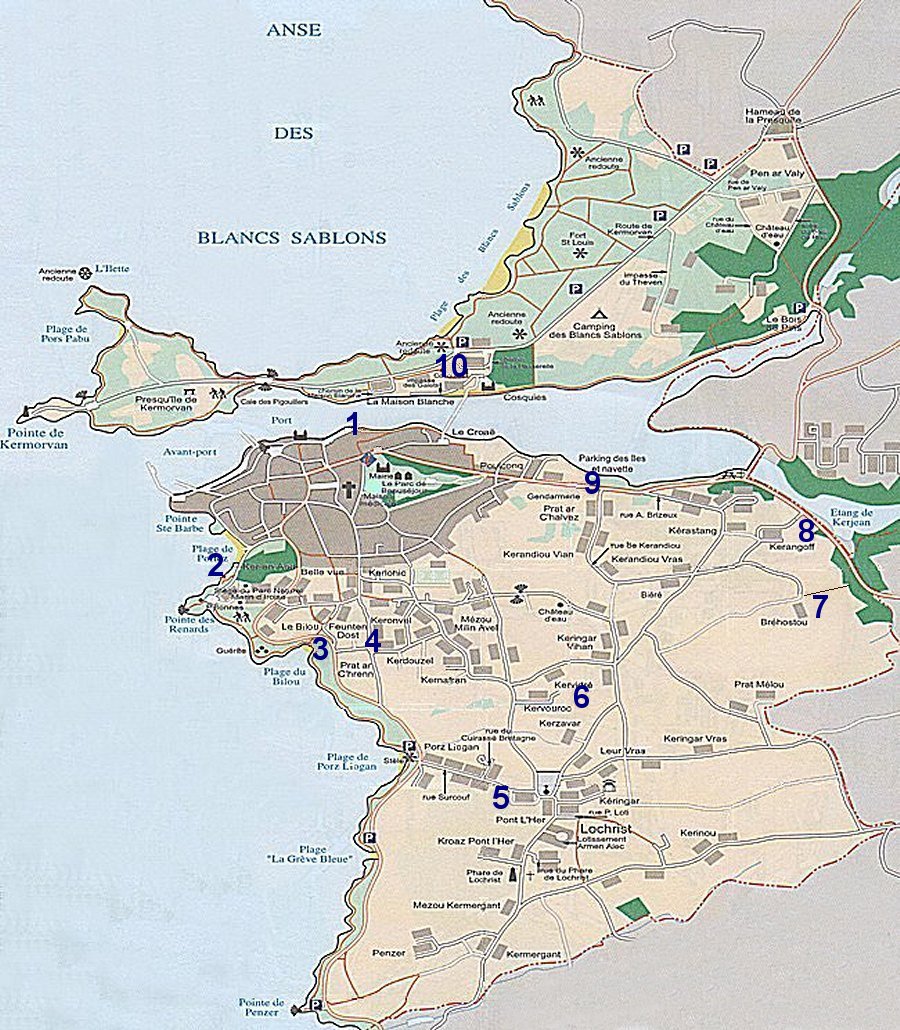As soon as you arrive in Le Conquet from Brest, you can see an impressive lavoir on the right bordering the Ria. This is a great introduction for the visitor to discover a part of the important and varied heritage of the town. There are ten ancient lavoirs in Le Conquet 1 and these are well worth the detour.
-1- The lavoir of Drellac'h

GPS : 48°21'41.4 N 4°46'19.7 W
Access:
Coming from Brest toward the town centre, park in the car park near the roundabout. Walk past the town hall and take the small alley on the right just after the restaurant "Ar Dagenta" which in Breton means the first stop ! At the junction turn left toward the port. Just in front of an old house built on the shore of the port, you will see the lavoir on the left.
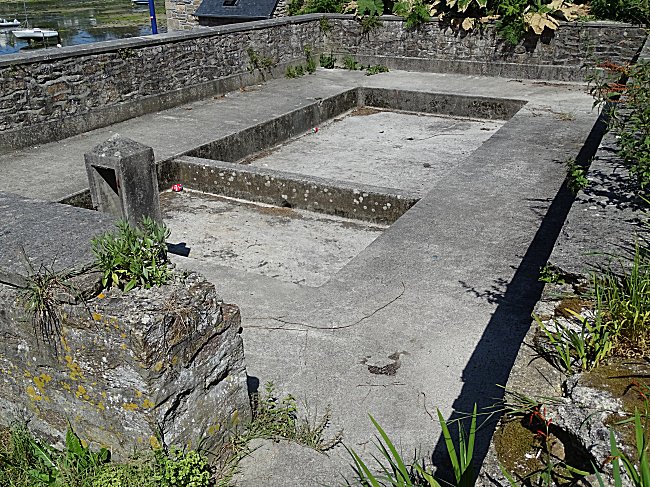
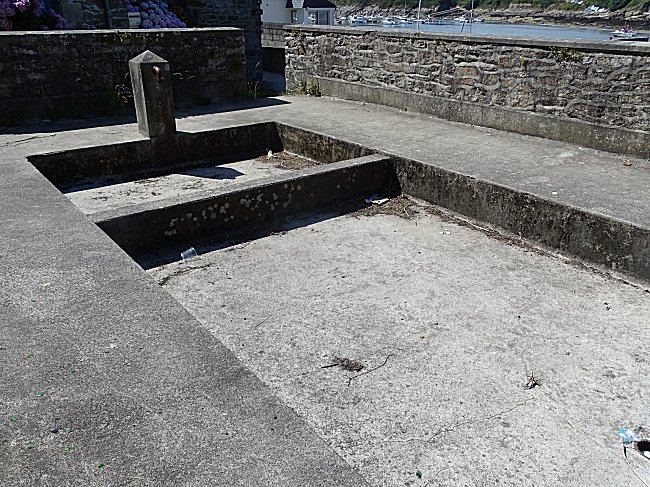
This is undoubtedly the most recently constructed lavoir. It has two distinct basins, in order to separate washing/soaping (the large basin) and rinsing (the small one). It is also entirely lined in cement and fed by a fountain. Water is supplied from the upper slopes by gravitation.


GPS : 48°21'18.4 N 4°46'46.7 W
Access:
Leaving the town toward La Pointe St-Mathieu, stop before the turning to Portez beach and park on the main road. Walk down the small lane that leads to the beach past the public toilets, then follow the path uphill toward the headland. Half way up enter the Promenade Jean Hobé2 set up as a belvedere above the shoreline. (
( little detour to this garden )
).
At the far end of the garden, steps lead down to the rocks where there is an ancient spring whose water was very popular at the beginning of the XXth century right up till the 1970s. In the past, one could access a tiny basin partiallly blocked today by large rocks as well as by the remains of a concrete staircase.
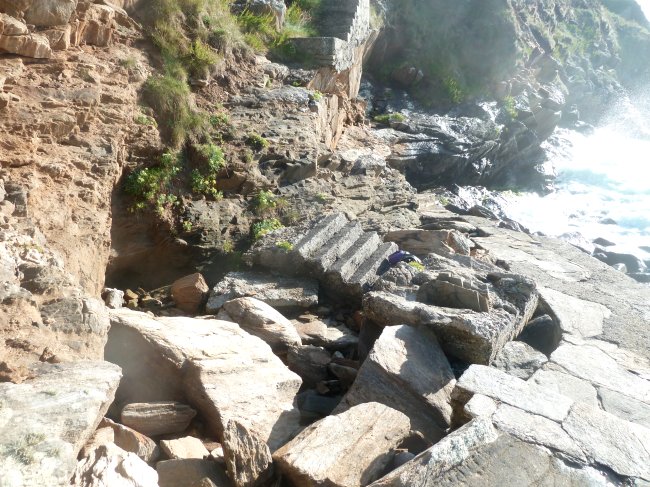
This basin is quite distinct from the spring itself and is the smallest lavoir in Le Conquet. Each high tide cleans the basin and it is no wonder the spring provided the most southt-after fresh water in the region, especially for sailors who needed to replenish their water supplies by navigating up to the rocks. The basin has not yet been rehabilitated, as it has been obstructed by a rockfall from the cliff. One can however make out its round shape.
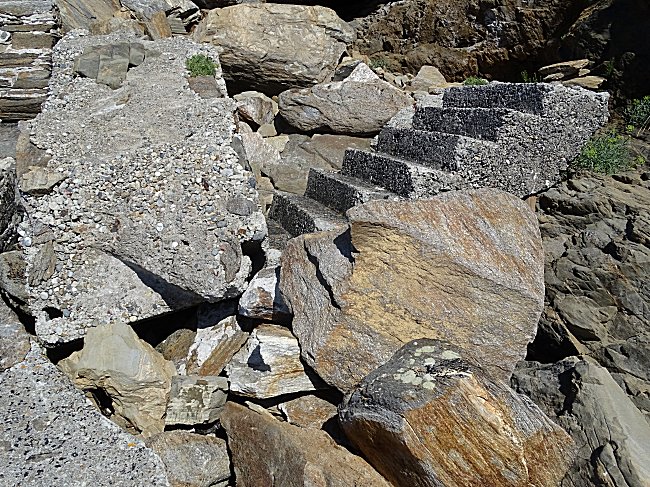
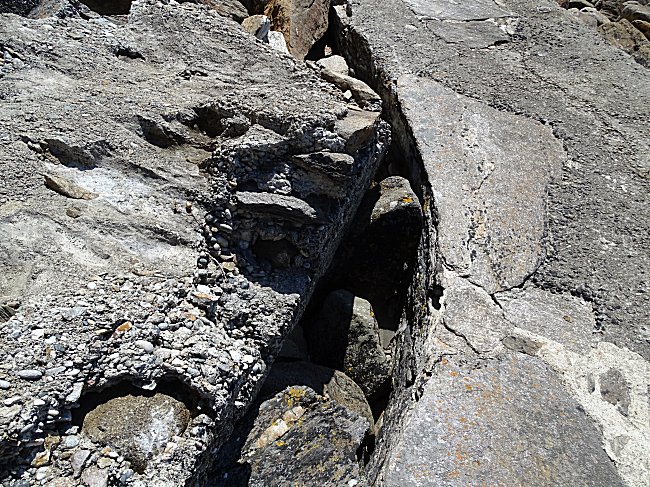

GPS : 48°21'08.7 N 4°46'27.9 W
Access:
Leave Le Conquet toward La Pointe St-Mathieu ( tourist road ) and park on the right side just before a speed bump. Then walk down the first small lane on the right that leads to Bilou beach. The lavoir is on the left, before the beach.
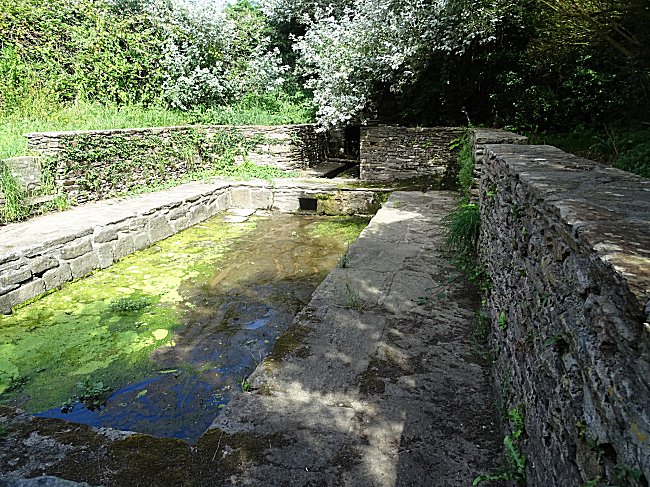
This large lavoir is located in a narrow valley called 'Porzh Feunteun', the port of the fountain. It was marked on ancient sea charts for good reason. Sailboats could approach the nearby beach to replenish their vital supply of fresh water. A spring constantly fills a small reservoir intended to draw clear water and a deep canal allows this water to reach the basin whose sides are delicately paved. The water drains off at the other end. But why such a deep channel? The answer is in the width of the slabs that border it: this long pit constituted a rinsing basin; the large basin was probably used for soaping from the end of the XIXth century.
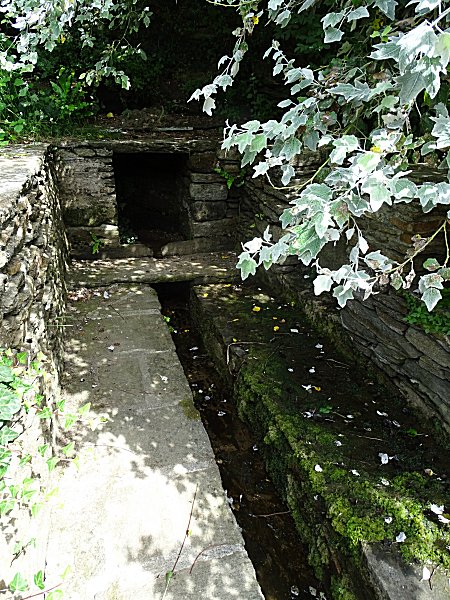
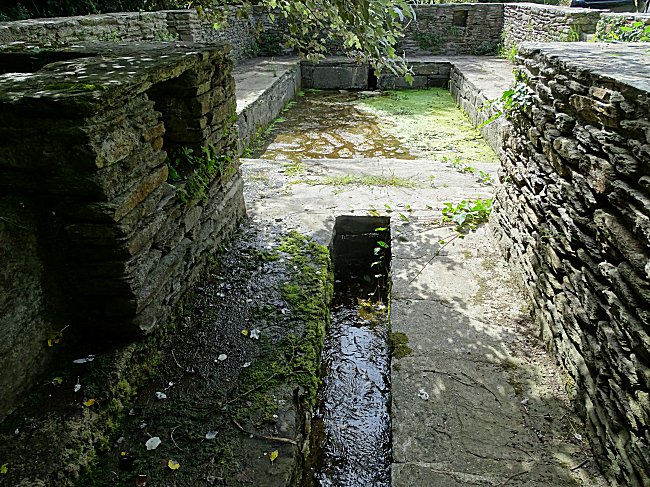
Note the three stiles that must be spanned to access the perimeter of the lavoir and the niches in the low wall to place personal accessories.
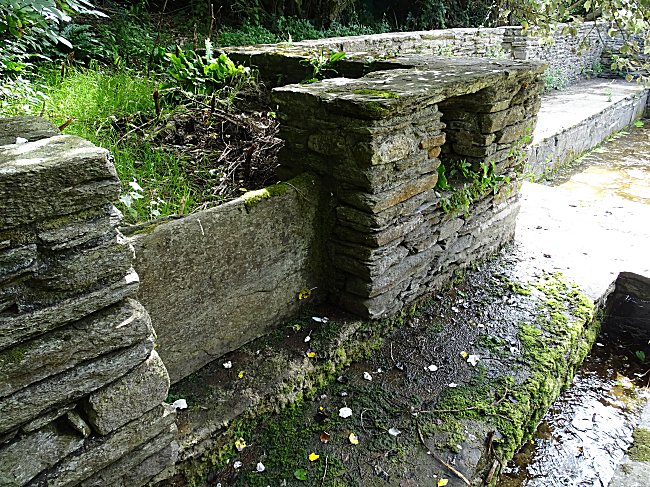

GPS : 48°21'08.8 N 4°46'16.5 W
Access:
From the centre of Le Conquet, walk past the church and continue along rue Poncelin then rue Albert de Mun in the direction of Lochrist. At the bend, take the rue de Dunkerque and continue along rue de Kerivin. Park next to the lavoir Prat ar C'hrenn (in Breton: the field of the stocky, or corpulent).
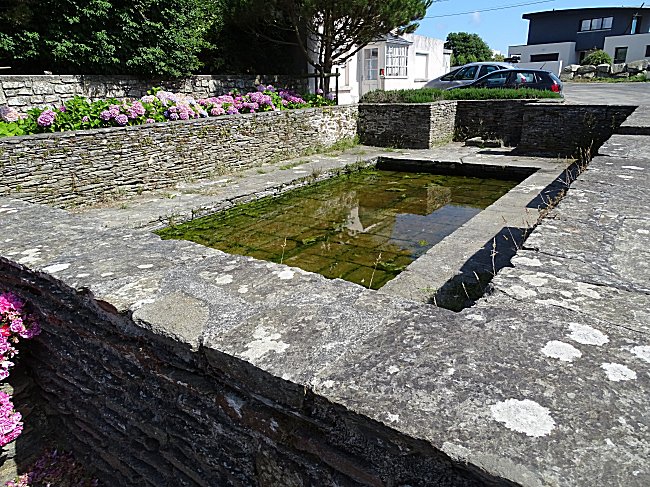
This is the largest lavoir in Le Conquet. It was built on the site of a vibrant spring that today flows only as a trickle.
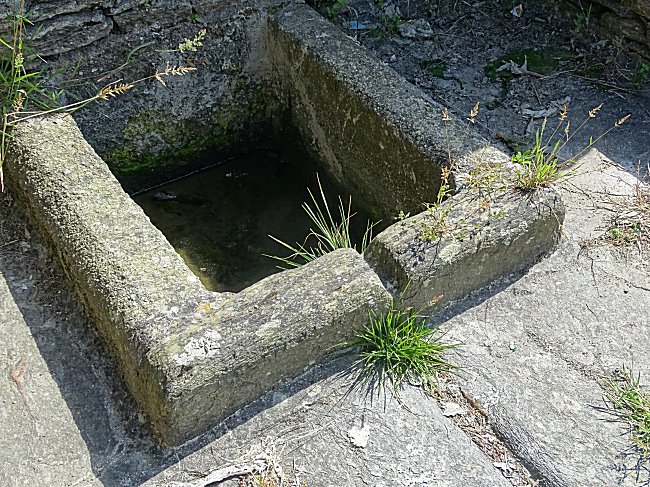
It is accessed by stiles to stop animals entrering. A channel, starting from the fountain and ending in a Y feeds the large paved basin. Note that a valve allows the lavoir to be emptied for cleaning purposes.
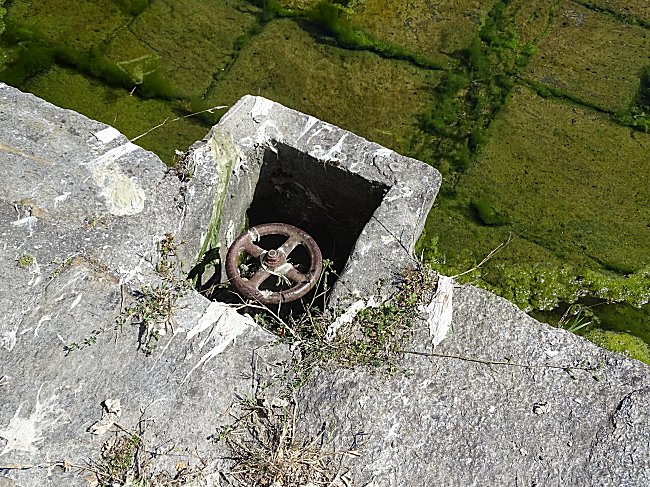

GPS : 48°20'44.8 N 4°45'49.4 W
Access:
Leave Le Conquet by the tourist road toward Plougonvelin and La Pointe St-Mathieu and turn left at Porsliogan beach. Then turn right into the 'rue du lavoir de Lochrist' and park in the square.
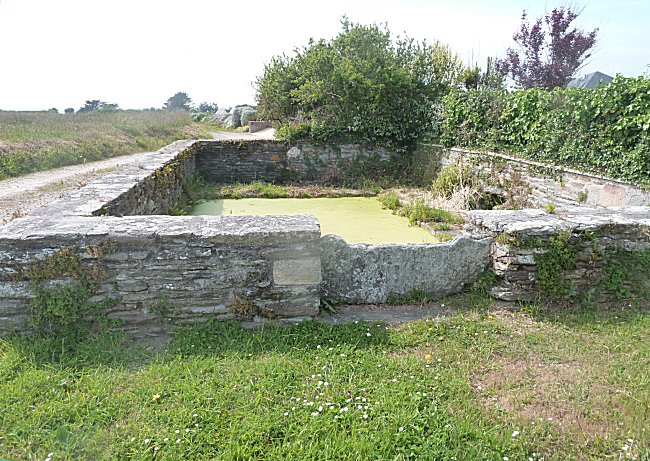
This is a large lavoir which reflects the importance of the village of Lochrist in bygone days. A single stile provides access. The basin is fed by a lateral tank from a gushing spring. The paved perimeter is cut by the outer wall. The wall was moved when the road was widened at the expense of the lavoir,
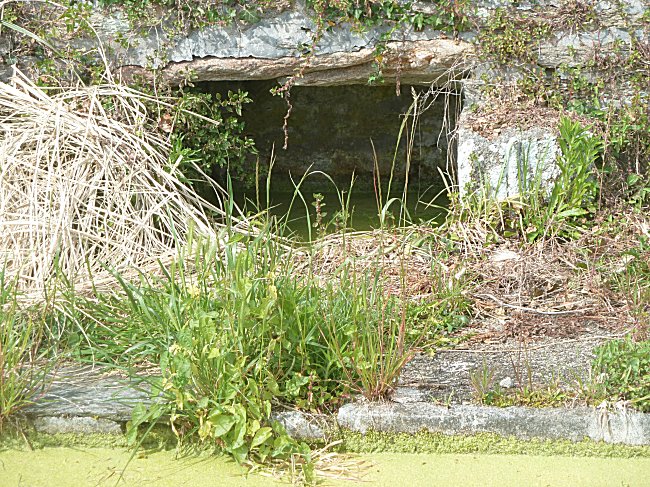
The opposite wall shows the reuse of a rounded carved stone that may have adorned the old church which was dismantled in 1856 to be rebuilt in Le Conquet in the up and coming village.
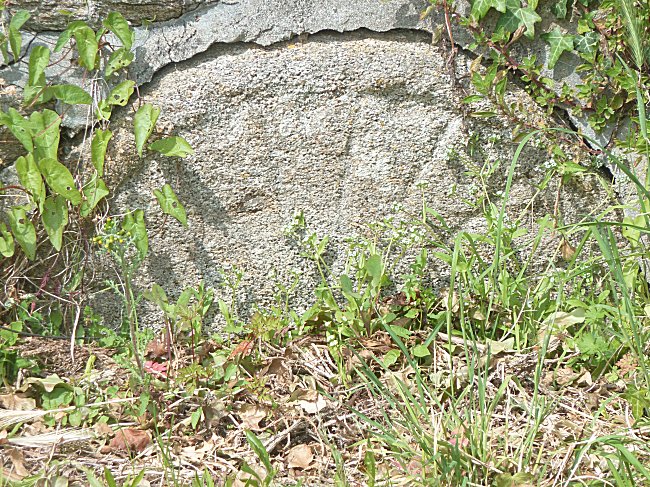

GPS : 48°21'01.1 N 4°45'41.2 W
Access:
Leave the centre of Le Conquet via rue Albert de Mun toward Lochrist and at the crossroads, cross over to rue de Kervidré. Park near the 2nd right lane. Follow this 'rue des Lavandières' on foot. It leads into a small wooded communal area on the right. The lavoir stands on the left.
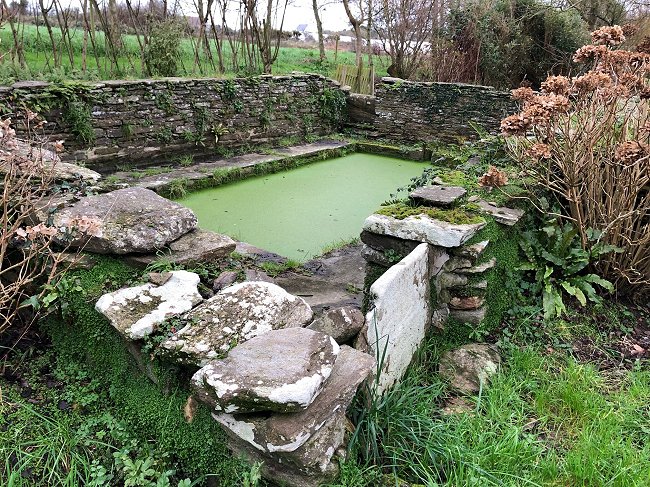
Photo: Glyn Orpswood
This lavoir is located in a particularly charming environment. It is necessary to step over the stile to observe the basin that is fed by the spring.
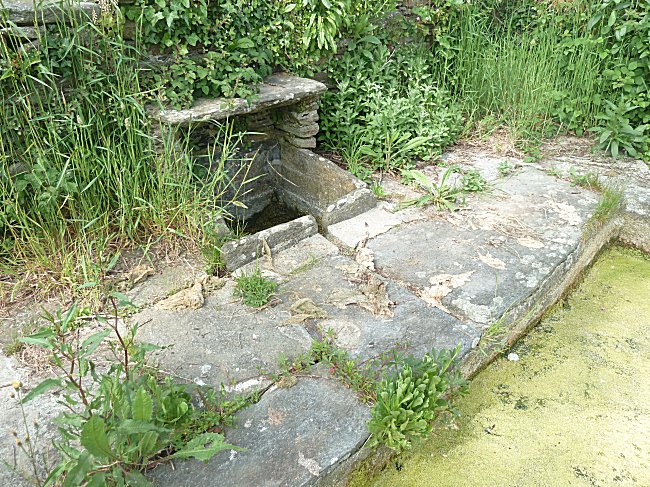
The basin has a well paved perimeter and is emptied using a valve next to which can still be seen an old metal washing container, the precursor for to day's washing machine. In the past, when the lavoir was used, an iron bar was employed to lift the valve and empty the basin for cleaning. " The edges were soaped before putting it back in place, recalls Marcel Quellec, deputy mayor of Le Conquet, and to ensure water tightness at the base, a large clod known as a "taouarc'h" in Breton was dug out from the nearby meadow, and pressed into place with the aid of a karn, a traditional iron tool known affectionately as the horse's horn hoof ! " ( in Breton, the word karn not only means 'hard' but also the horse's horn hoof ).
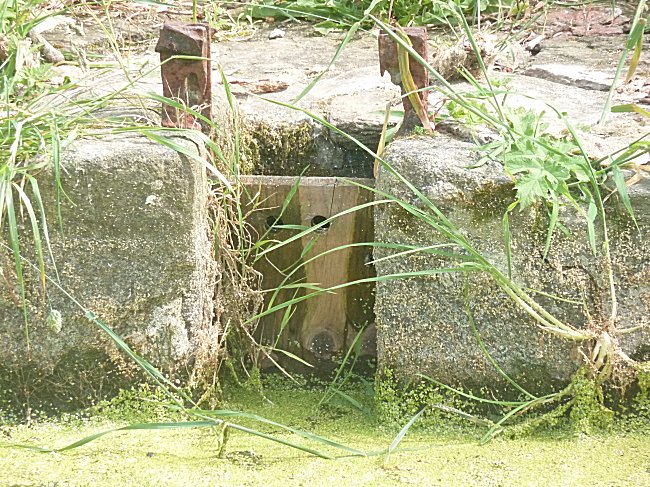
The water empties out into a now-forgotten pond. This quiet and shady place is a haven to walkers and many small animals that live or drink there and evokes delightful memories to Marcel Quellec :
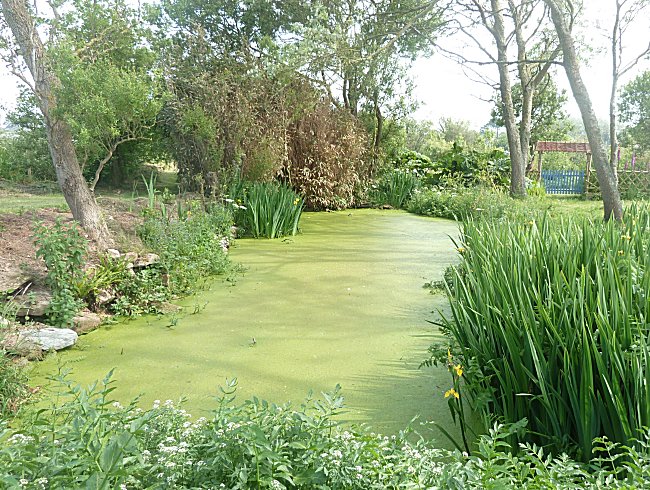
" If there is a place close to my heart, he says, it is the Kervouroc lavoir and its surroundings. I cannot cross the stile without hearing the echo of my childhood and my youth flitting between the stones. The beaters clacking on the wet sheets, the strong burps of thirsty cows that have greedily drunk the water poured into the trough with heavy buckets by such frail arms, the harvesters laughing as they shook off the threshing dust, the swallows and swifts screeching around the reeds of the pond... The poplars my father had planted leaning over this abandoned lavoir. " 3
7- The lavoir of Bréhostou

GPS : 48°21'19.3 N 4°44'50.7 W
Access:
Leave Le Conquet toward Brest and in front of the inner harbour, at the first bend, take the rue Brizeux. Turn left at the second street toward Kerangoff. At the end of this street, at the corner of an attractive well, turn right up Kerangoff street and take the first small road on the left. At the bend, you will see a wide path on the left that leads to a copse. Park there, the lavoir is hidden under the trees.
This lavoir can be totally covered by vegetation for part of the year.
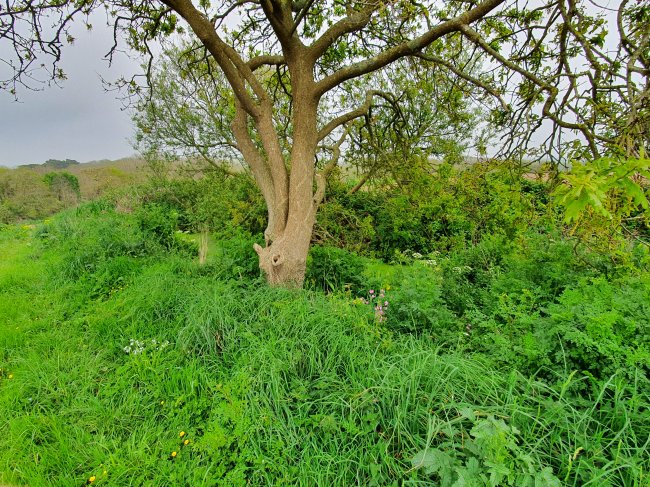
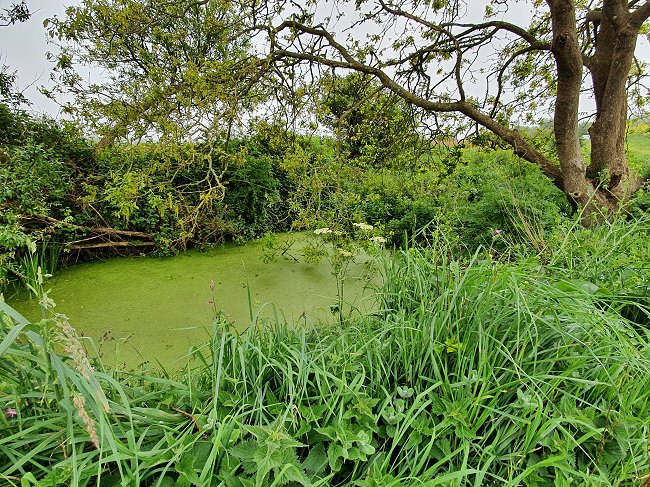
It has the particularity of being extended with a vast pond dug out during the 1970's for cauliflower crops. Its access is sometimes slippery.
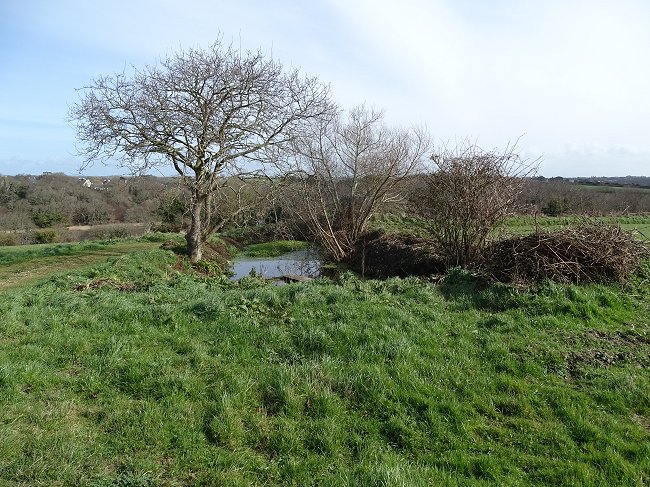

Therefore, be careful or risk an unintentional dip !
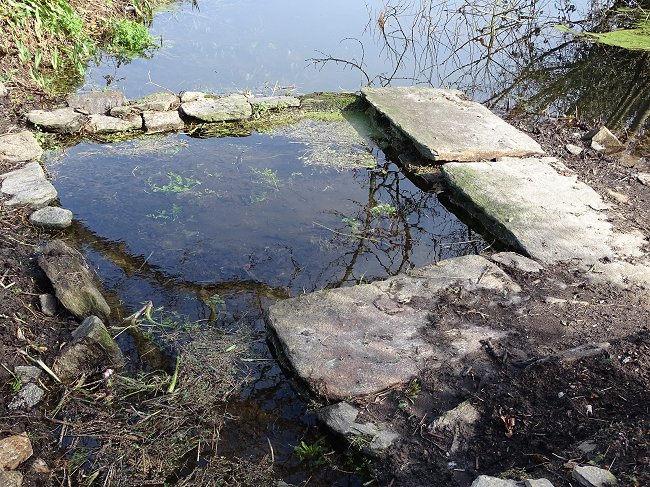
Another peculiarity about this very isolated lavoir was that it was never intended for a large number of people. The three large slabs were enough for the women of Brehostou only. Two of these very wide stones are currently far from the edge, but this was not the case before the pond was dug. The slab located near the spring was used as access to the lavoir.
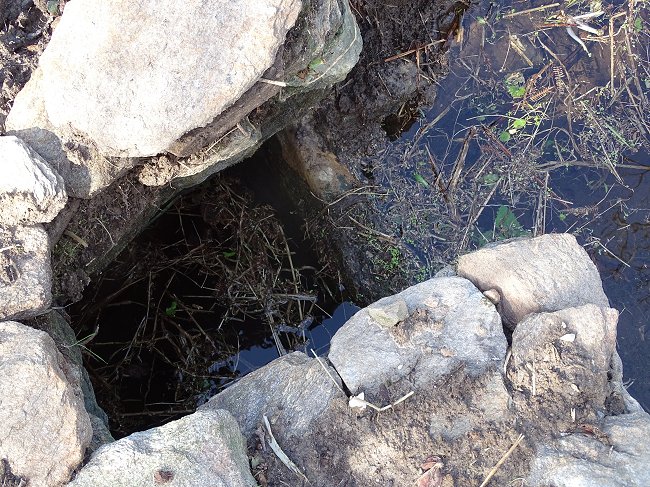
This spring is protected by a low thick wall in order to prevent a landslide from blocking it. This small lavoir in the countryside demonstates a well thought out organization and probably provided sterling service for its former users.
8- The lavoir of Kerangoff

GPS : 48°21'29.2 N 4°44'53.2 W
Access:
Leave Le Conquet toward Brest. At the end of the Ria, just past the turning on the left to St-Renan, park on the right in a narrow car park. Continue on foot along the Brest road and take the street on the right. The lavoir is under the trees, on the left side.
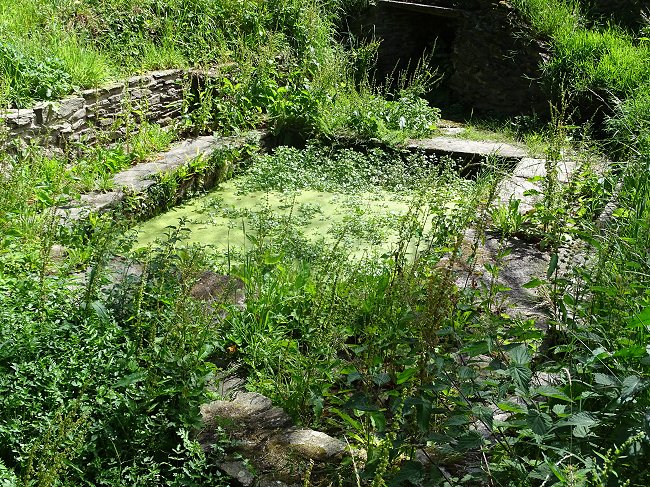
You can see in the above picture that this small lavoir was overgrown with vegetation, but it has been recently cleared.

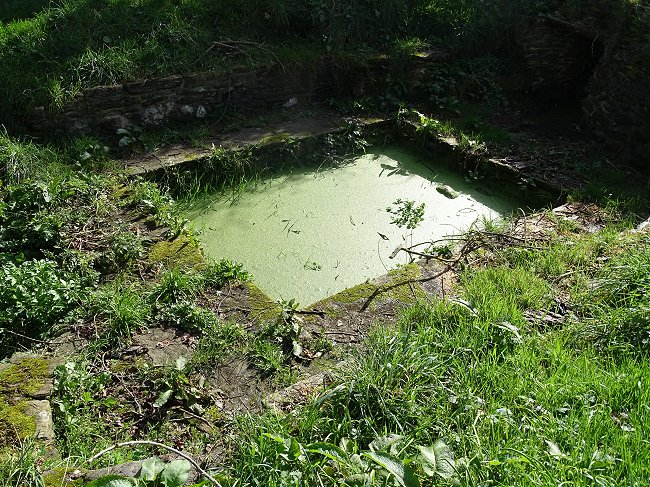
Its large basin is lined with wide slabs of schist.
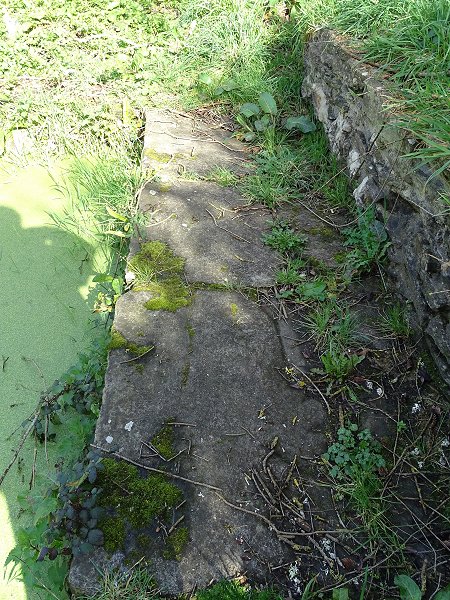
A spring supplies and fills a small reservoir in a stone niche that flows into the basin.
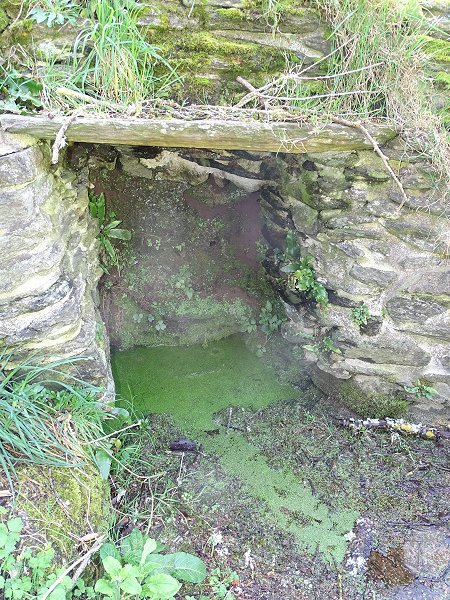
The surprising absence of a rinsing tank suggests that this small reservoir was used for rinsing. However, thorough clearing off the site may yet reveal hidden treasures.
9- The lavoir of Prat ar C'halvez

GPS : 48°21'33.4 N 4°45'29.2 W
Access:
This lavoir is located at the entrance to the town when coming from Brest. You can park next to it.
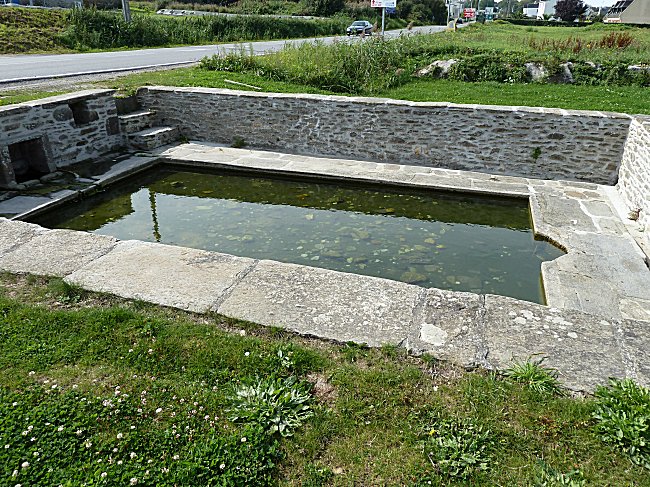
This large and well maintained lavoir was built on a plot whose name indicates that it was not intended for this purpose. In Breton, "Prat ar C'halvez" means the carpenter's meadow. However, there has been no wood craftsman in this place for a long time. However, ships could have been built in this place near the shore at the end of the Middle Ages4. A spring fills there.
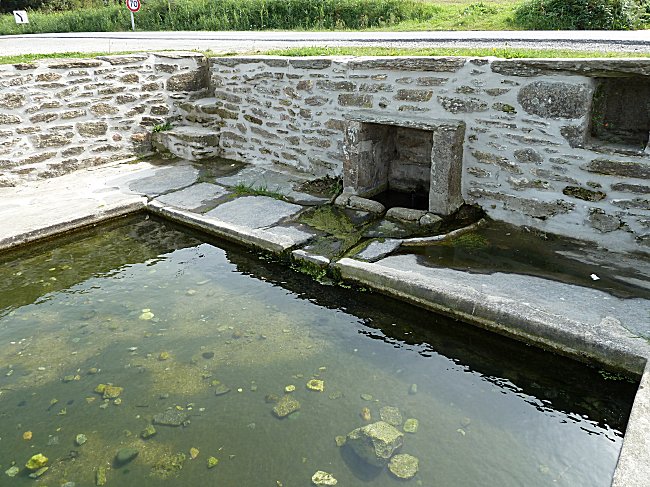
It fills a small well sheltered tank in a niche. Poeple filled containers there with drinking water. A canal dug in the stone then leads to the wide basin bordered by the large slabs where the washerwomen stood and knelt. These schist slabs were extracted from the rocks of Le Conquet foreshore, between La Pointe Ste-Barbe and Bilou beach.
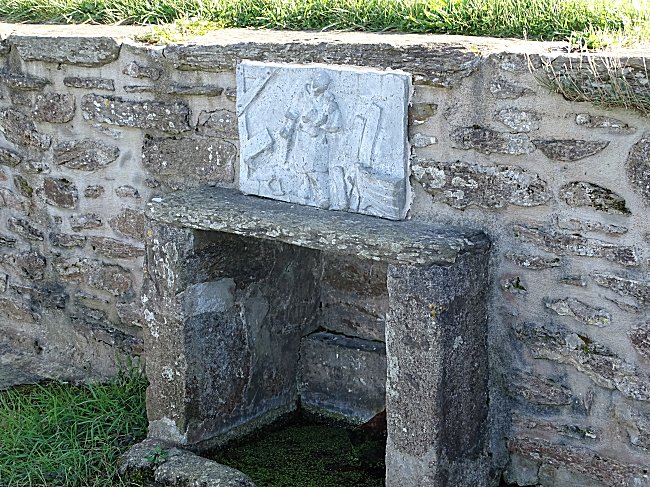
The niche of the fountain has recently been decorated with a bas-relief by Catherine Cloup, a local artist from Le Conquet. It represents a ship's carpenter in full swing and cleverly illustrates the Breton name of the lavoir.
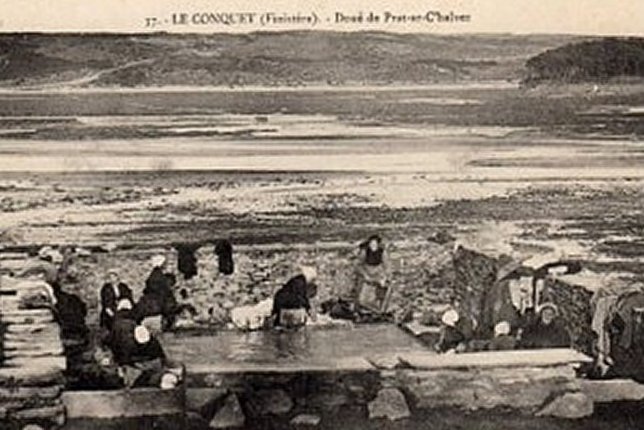

GPS : 48°21'52.1 N 4°46'01.5 W
Access:
Leave Le Conquet by heading on the Brest road and turn left toward St-Renan. At the first crossroads, take the road to Plouarzel. 1,2 km further, turn left toward the headland and the Blancs Sablons beach. 500 m after the campsite, stop on the right in a car park lined with large trees. Continue on foot 30 m on the road and go down the path on the left. The lavoir is a little lower down near the path.
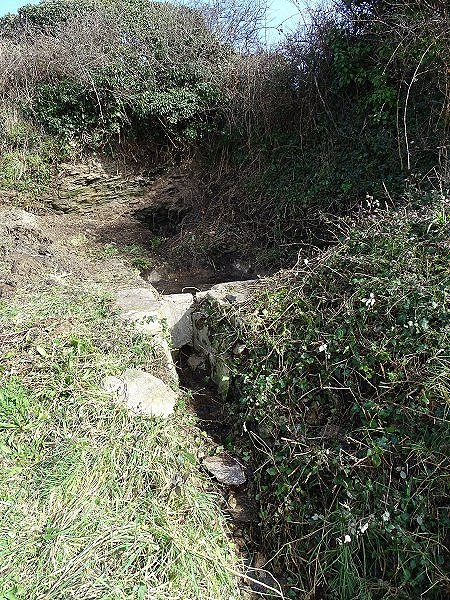
This tiny lavoir is still called by the name of its last user. "Léonie's Lavoir" had all but disappeared in the undergrowth but was intensively cleared during the 2017 winter.
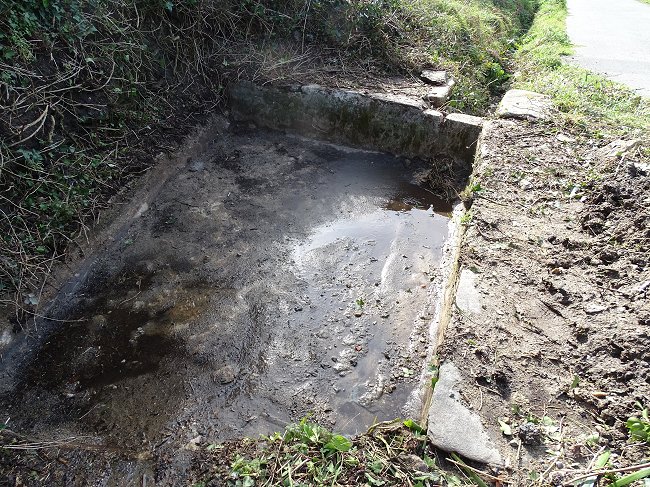
If you are surprised by the small size of its single basin, you may also be taken aback by its design: it is only bordered by stones laid on edge, no flat slab surrounds it and the washerwomen probably had no other choice than to put their washing box and their laundry basket directly on the ground.
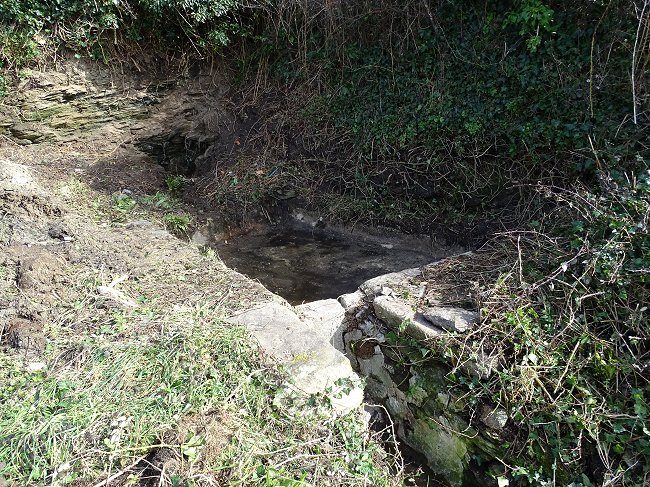
Its flow can be closed by a board to let the basin fill. Its natural spring is not yet completely cleared. But it has been roughly carved into the rock in order to increase its flow.
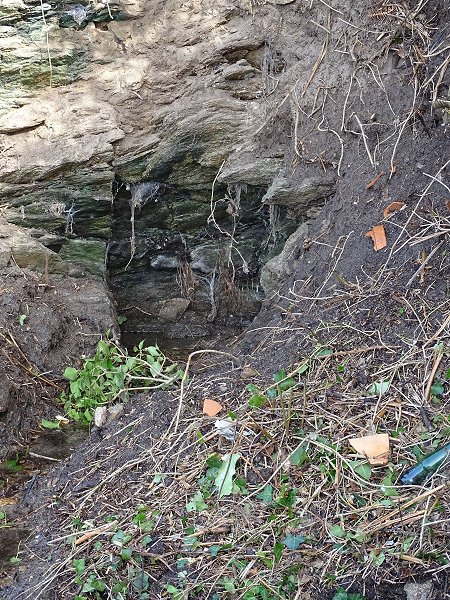
And so here we end our Journey of the Lavoirs of Le Conquet. A Journey which takes you back in time to what was certainly a daily if not weekly event for the womenfolk of Le Conquet. Spare a moment's thought to the seafaring men who risked their lives navigating around this rocky coasline and filling up their empty barrels with fresh water from the spring at Portez or Le Bilou.
Click on the image below and print your walking itinerary to discover the lavoirs of Le Conquet.
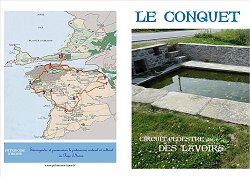
1- There are also other lavoirs in Le Conquet, such as the private lavoirs in Kerzavar and Kerouanton. In Plougonvelin, the public lavoir of Goazel was also used by the inhabitants of Le Conquet.
2- Jean Hobé was a keen gardener from farming stock, who worked in Loperet, for Le Radar de Bretagne. When he retired, he volunteered toiled tirelessly for many years to create this charming garden overhanging the cliffs of Portez beach. Take a few minutes to admire the breath-taking view before visiting down the spring.
3- Bulletin municipal du Conquet " De Penzer à Kermorvan " n°99, July 2016.
2- Bulletin municipal of Le Conquet " De Penzer à Kermorvan " n°100, January 2017. See Maj. Hubert Michéa's
(Hubert Michéa).
Thanks to Marcel Quellec for his collaboration and the narration of his childhood memories.
Thanks also to the various teams of volunteers as well as to the municipal employees who have the hard task of regularly maintaining this small but significant heritage. Finally and especially thanks to Glyn Orpwood who reread this text and modified the English version.





